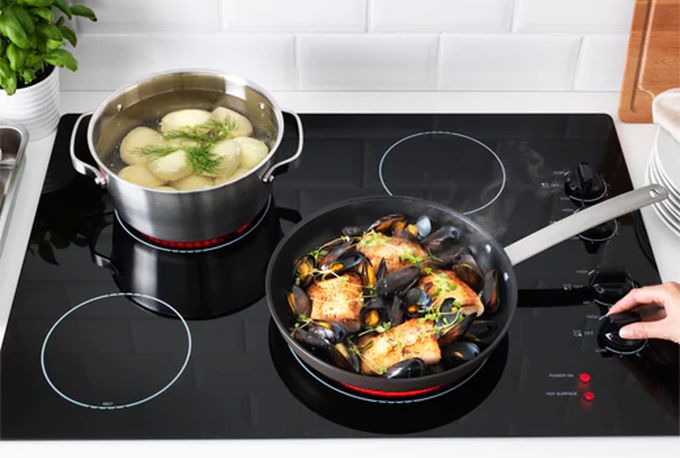Glass-ceramics was developed in the middle of the last century for the systems of mirrors in astronomical telescopes. After several decades, companies began to actively use this material in household appliances. The last few decades, cooktops with a glass ceramic surface are some of the most common and popular.
The process of manufacturing glass-ceramics is simple. Plates of green glass a few millimeters thick are cut into the required parts. The contours of the burners, various indicators and any patterns are made inside the glass at the molecular level.
Therefore, the mechanical influence cannot damage pattern during cooking or cleaning. Thereafter, the panel undergoes ceramization. This technology is the bombardment of the glass surface by crystals at a temperature of more than 900 degrees. German SCHOTT AG (Ceran brand) and French EuroKera are among the leaders in this segment.
Of сourse, glass-ceramic panels have a high cost, but they are very beautiful and comfortable. Heating elements (ceramic, halogen or induction burners) and residual heat indicators are placed under the panel. Glass-ceramics has a unique ability of very effective transmission heat to the heating area. Moreover, heat exchange is very uniform and fast. Therefore, the thermal inertia is very low. Of course, such panel has a very short duration of heating and cooling. The borders of heating are clearly delineated that eliminates the risk of burns by an occasional touch. Perfectly flat and smooth surface provides very convenient cleaning. Moreover, сooktop with glass-ceramics surface is economical enough.
Today, glass-ceramic panels are mainly used in electric cooktops.
Virtually all induction cooktops are equipped with glass-ceramic. But porous glass-ceramic opens the possibility of its use in gas cooktops.
Design
Design of the glass-ceramic models is very stylish and diverse. The choice problem is absent even among buyers with the most exquisite taste. Snow-white and ivory, black anthracite and brown, black with gray dots and steel, aluminum and mirror, cold ice is not a complete list of proposed colors. For many consumers, this factor is often one of the most important when choosing a cooktop.
Some models are decorated with patterns that look very bright on the glass-ceramics. For example, the design of cooktop is made as astrological chart.
Any defects and pollutions are clearly distinguishable on a flat glass-ceramic surface. Therefore, models with pattern are more practical.
Cooktop contains the contours of heating zones. Many models also have different icons and symbols-tips that improve usability.
Today, some companies are developing models with porous glass-ceramic that allow manufacturers to abandon traditional heating elements. This technology is called gas on glass or gas under glass. The name of such models often contains a GPC abbreviation.
It uses special ceramic gas burners that convert heat from gas combustion to infrared radiation. This energy is transferred to the panel to heat the cookware. The gas burns almost completely at 800 degrees. Therefore, the air in the kitchen remains clean even after prolonged cooking.
Disadvantages
Unfortunately, glass-ceramic also has several cons. This list contains:
– the liquid on the cooktop spreads over the entire flat surface. This situation often occurs during a violent boil.
– glass-ceramics requires the use of cookware with a completely flat and smooth bottom. Its diameter must match to cooking zone diameter. The bottom outside of the cooking zone can cause the formation of spots on the surface.
– glass-ceramic has low mechanical strength. It withstands a blow no more than 4.4 lb. Fall of sharp object may cause to the chipping on the surface.
– glass-ceramic is very sensitive to sweet liquids that leave stains on the surface. The sugar at high temperatures changes the structure of the glass-ceramic surface. Seashells on the cooktop begin to form after 15 minutes after contact. Therefore, such contamination requires immediate cleaning before it cools.
– glass-ceramic is sensitive to the cold water that can cause a crack. Correct cleaning and care of glass-ceramic is demonstrated on video.
